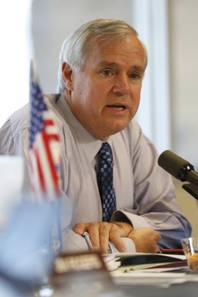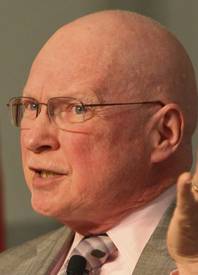Saturday, March 20, 2010 | 2:01 a.m.

Chancellor Dan Klaich

Fred Maryanski
Sun archives
- Gibbons’ education task force to meet behind closed doors (3-19-2010)
- Gibbons forms education task force; Elaine Wynn to co-chair (3-15-2010)
- Gibbons’ new ideas for education have a familiar ring to them (3-6-2010)
- Gibbons outlines six-step plan for higher education (3-4-2010)
- Education cuts could mean bigger class sizes (2-28-2010)
- Democrats: Trim education cuts to 5 percent (2-24-10)
- Budget crunchtime: Lawmakers set to tackle historic deficit (2-23-10)
Because the Silver State is unique in how it oversees public colleges and universities through the Nevada System of Higher Education, it is better positioned to respond to the budget crisis than other states.
The Nevada Constitution created the Board of Regents — a single, publicly elected and accountable body to oversee all higher education.
“That was brilliant,” Regent Mike Wixom said. “It was probably unintentional brilliance, but it was brilliant nonetheless.”
Especially compared to, say, California’s independent, three-tier higher ed system: the University of California, California State University and California Community Colleges, each with its own governing body.
Although such autonomy might be preferable when money is plentiful, during a time of fiscal crisis it can make it more difficult to respond quickly, make necessary adjustments and share resources.
Nevada’s Board of Regents “can look at shared resources, shared purchasing, shared personnel,” Wixom said. “The only positive thing out of this whole horrible process is that we’re one system.”
Whether appearing before the regents or their communities to discuss impending budget cuts, campus presidents have been careful not to cultivate an “us or them” mentality. But that doesn’t mean there still isn’t significant concern among faculty, staff and students that the scales used to measure the worth of “us” — the immediate campus — might instead tip the available funding in favor of “them” — the rest of the higher ed system.
After all, the decisions rest not with the presidents but with the regents, who must approve all budget-reduction plans.
There is heightened anxiety for Nevada State College in Henderson. When the campus opened eight years ago, it moved the state a step closer toward the regents’ goal of a three-tiered system. UNR and UNLV would burnish their research missions. The community college system would serve as the open-access entry level to higher ed for the broader community. And Nevada State College would fill the middle gap, as the sole option for students seeking four-year bachelor’s degrees who might not make the academic cutoff for entry to UNLV or UNR.
Because it’s the youngest branch on the higher ed tree, there are fears among students, staff and supporters that Nevada State College might be unfairly targeted for fiscal pruning.
Those fears were heightened in part when university system Chancellor Dan Klaich used the closing of the college as a possible scenario to illustrate the enormity of the fiscal crisis.
To be sure, the college is playing an important role, with enrollment up 20 percent over 2009, the fastest rate of growth of any campus in the system. Two-thirds of the students are in education or nursing programs. And about 90 percent of the college’s graduates remain in the state.
“We are producing fruit as expected,” President Fred Maryanski said.
At the regents’ special meeting April 16, Maryanski will present a plan for meeting the 6.9 percent reduction in state funding mandated by the Legislature during the recent special session. Nevada State College’s annual operating budget is about $16 million.
Most of the cuts will come from leaving faculty and staff positions vacant, he said, rather than cutting classes or raising fees.
“We’ll continue with some internal pain and hopefully not transfer that to our students,” Maryanski said.
Wixom says he’s fielded plenty of calls from constituents concerned about the college’s fate — and they shouldn’t worry.
“Am I still committed to a three-tier system?” he says. “You bet I am.”
Regent Kevin Page says it’s not a question of “open or closed,” but how the college’s landscape and mission will have to adjust to the new reality.
“I don’t think it’s fair to say, ‘Keep NSC open, don’t make any changes and cut the rest of the system,” Page said. “We have to look at this from a realistic perspective. None of the campuses is going to look exactly the same.”
There could be future opportunities for better synergy. In January, College of Southern Nevada began offering midnight classes to meet demand for popular core academic subjects. There might be opportunities for CSN to share facilities and even faculty with Nevada State College so that students could have more access to daytime classes, Page said.
Wixom echoed Page.
“We’re not looking at NSC in a silo,” Wixom said. “We see the college as just one of the important resources we have, in a system to meet the needs of students and the state.”

Join the Discussion:
Check this out for a full explanation of our conversion to the LiveFyre commenting system and instructions on how to sign up for an account.
Full comments policy